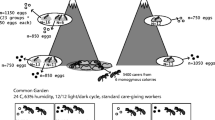Summary
The sex ratio of investment (SRI) or male investment frequencies (IFs) were estimated at the population and colony level in populations ofL. alienus, L. niger and their hybrids. More simlarity betweenL. alienus IFs and the hybrid IFs than between compatibility of these data with predictions dependent on the caste or intra (in the instance of workers) and inter caste conflict as determinants of the IF. An estimate of intra colonial, worker relatedness in aL. alienus population was significantly greater than zero. Whilst being consistent with the monogynous structure attributed to this species the 95% confidence limits of the relatedness value would also accommodate a degree of polygyny and/or multipe mating.
Resume
La sex-ratio de l'investissement reproductif (SRI) ou la fréquence de l'investissement mâle (IFS) ont été évaluées au niveau de la population et des colonies dans des populations des fourmisL. alienus, L. niger et leurs hybrides. Une plus grande similarité a été notée entre l'IFS correspondant àL. alienus et aux hybrides qu'entre ces derniers et l'IFS deL. niger. Ceci a été étudié en rapport avec la compatibilkités de cette information avec des prédictions reposant sur la caste et le conflit intra- (dans le cas des ouvrières) et inter-castes comme déterminants de IF. Une évaluation de la relation des ouvrières entre elles à l'inteérieur d'une même colonie dans une population de fourmisL. alienus a été significativement supérieure à zéro. Bien qu'étant en accord avec la structure monogyne attribuée à cette espèce les limites de confiance au seuil de 95% du degré de relation pourrait aussi correspondre à un certain degré de polygynie et/ou de fécondation multiple.
Similar content being viewed by others
References
Alexander R.D., Sherman P.W., 1977. — Local mate competition and parental investiment in social insects.Science, 196, 494–500.
Boomsma J.J., Van der Lee, G.A., Van Have, T.M., 1982. — On the production ecology ofLasius niger (Hymenoptera: Formicidae) in successive coastal dune valleys.J. Anim. Ecol., 51, 975–991.
Brian M.V., 1979. — Habitat differences in sexual production by two co-existent ants.J. Anim. Ecol., 48, 943–953.
Craig R., Crozier R.H., 1979. — Relatedness in the polygynous antMyrmecia pilosula.Evolution, 33, 335–341.
Donisthorpe H., 1927. — British Ants — their life histories and classification.,G. Routledge & Sons Ltd., London, p. 436.
Hamilton W.D., 1972. — Altruism and related phenomena, mainly in social insects.Ann. Rev. Ecol. Syst., 3, 193–232.
Herbers J.M. 1979. — The evolution of sex ratio strategies in Hymenopteran societies.Am. Nat., 114, 818–834.
Lubbock J., 1882. — Ants, Bees, and Wasps. A record of observations on the habits of the social hymenoptera.Kegan, Paul & Trench, p. 448.
Orlove M.J., 1975. — A model of kin selection not invoking coefficients of relationship.J. Theoret. Biol., 49, 289–310.
Oster G.F., Wilson E.O., 1978. — Caste and ecology in the social insects.Princeton University Press, p. 352.
Pamilo P., 1982. — Genetic evolution of sex ratios in eusocial hymenoptera: allele frequency simulations.Am. Nat., 119, 638–656.
Pamilo P., Crozier, R.H., 1982. — Measuring genetic relatedness in natural populations: methodology.Theor. Popul., Biol., 21, 171–193.
Pamilo P., Rosengren R., 1983. — Sex ratio strategies inFormica ants.Oikos, 40, 24–35.
Pamilo P., Varvio-Aho S., 1979. — Genetic structure of nests in the antFormica sanguinea.Behav. Ecol. Socibiol., 6, 91–98.
Pearson B., 1982. — Relatedness of normal queens (macrogynes) in nests of the polygynous antMyrmica rubra Latreille.Evolution, 36, 107–112.
Pearson B., 1983a. — Intra-colonial, relatedness amongst workers in a population of nests of the polygynous antMyrmica rubra Latreille.Behav. Ecol. Sociobiol., 12, 1–4.
Pearson B., 1983b. — Hybridisation between the ant speciesLasius niger andLasius alienus — the genetic evidence. Insect. Soc.,30, 402–411.
Shaw C.R., Prasad R, 1970. — Starch gel electrophoresis of enzyme — a compilation of recipes.Biochem. Genet., 4, 297–320.
Trivers R.L., Hare H. 1976. — Haplodiploidy and the evolution of social insects.Science, 191, 249–263.
Ward P.S., 1983a. — Genetic relatedness and colony organisation in a species complex of ponerine ants. I Phenotypic composition of colonies.Behav. Ecol. Sociobiol., 12, 285–299.
Ward P.S., 1983b. — Genetic relatedness and colony organisation in a species complex of ponerine ants. II Patterns of sex ratio investment.Behav. Ecol. Socibiol., 12, 301–307.
Author information
Authors and Affiliations
Rights and permissions
About this article
Cite this article
Pearson, B. The sex ratio of heathland populations of the antsLasius alienus, lasius niger and their hybrids. Ins. Soc 34, 194–203 (1987). https://doi.org/10.1007/BF02224084
Received:
Accepted:
Issue Date:
DOI: https://doi.org/10.1007/BF02224084




